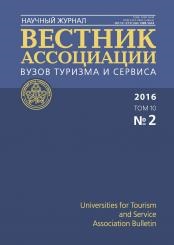Moscow, Russian Federation
Moskva, Moscow, Russian Federation
The article examines the questions of informational and methodological support of the assessment procedures and analysis of the benefits and risks of tourism development at the municipal level. The information, obtained by expert, is described. It includes monuments; farms and estates; religious sites – churches, temples, cathedrals and monasteries; memorial sites and places of military glory; objects of natural reserve Fund (NRF); beach areas and places of recreation; hunting and fishing sites; museums, museums-reserves, exhibition halls; industrial, agricultural enterprises and organisations that have already become the objects to show or have the potential to become; folk arts and crafts. Assessment objectives of tourism infrastructure in the settlements are associated with the analysis of the state of accommodation facilities, catering, entertainment and Park recreation areas. The method for the quantitative evaluation of the attractiveness of tourism resources and the quality of the tourist infrastructure of municipalities on the basis of expert procedures is described. The technique is approved on the settlements of the Klin district. Quantitative indicators of comprehensive assessment of the attractiveness of tourism resources and the quality of tourist infrastructure are introduced and experimentally approved, as well as indicators of settlements on these characteristics are generalized. The results of the ranking of settlements in the district are described on summary measures. There are proved two possible strategies for development of tourism in the region: extensive, according to which resources are directed towards the development of tourism in accordance with the obtained grades that will allow to achieve a relatively quick economic effect with respect to the settlements with higher grade, however, will slow the development of tourism in settlements with low grades; system – in accordance with existing territorial differences in the distribution of tourist resources and tourist infrastructure zoning district is realized to strengthen the weak areas at the expense of well-developed tourist areas.
tourist resources, tourist infrastructure, municipality, assessment methodology, expert information
Проблемы оценки туристских ресурсов и качества туристской инфраструктуры весьма актуальны, выступая в качестве основы эффективного управления в сфере туризма и туристской деятельности [2; 4; 9]. Методика анализа и оценки туристских ресурсов и туристской инфраструктуры связана как с достаточно сложными математическими моделями [2; 3, 5; 6], так и с более простыми методами количественного анализа [10–13]. В настоящей статье авторы дают описание методики и результатов экспертной оценки [1] состояния туристских ресурсов и качества туристской инфраструктуры на примере поселений Клинского района, входящего в систему дестинаций Северного Подмосковья.
1. Litvak B. G. Ekspertnaya informatsiya. Metody polucheniya i analiza. M.: Radio i svyaz´, 1982. 184 s.
2. Minaev V. A., Platonova N. A., Pogrebova E. S. Metodika analiza kachestva regional´noy infrastruktury turizma i turistskogo servisa//Vestnik Assotsiatsii vuzov turizma i servisa. 2014. T. 8. № 2. S. 38-48.
3. 2015).
4. Minaev V. A., Seselkin A. I. Modelirovanie ustoychivogo razvitiya turizma v regionakh// Vestnik Universiteta (Gosudarstvennyy universitet upravleniya). 2014. № 21. S. 40-46.
5. Minaev V. A., Ul´yanchenko L. A., Tsyshchuk E. A. Planirovanie razvitiya turistskoy otrasli v usloviyakh rezkikh makro- ekonomicheskikh izmeneniy. Servis v Rossii i za rubezhom. Elektronnoe periodicheskoe izdanie. T. 8. 2014. Vyp. 8. [Elektronnyy resurs]: http://old.rguts.ru/electronic_journal/number55/contents (Data obrashcheniya
6. Minaev V. A., Faddeev A. O. Otsenki geoekologicheskikh riskov. Modelirovanie bezopasnosti turistsko-rekreatsionnykh territoriy. M.: Infra-M, 2009. 370 s.
7. Minaev V. A., Faddeev A. O. Bezopasnost´ i otdykh: sistemnyy vzglyad na problemu riskov. Turizm i rekreatsiya: fundamental´nye i prikladnye issledovaniya Trudy II Mezhdunarodnoy nauchno-prakticheskoy konferentsii. 2007. S. 329-334.
8. Minaev V. A., Faddeev A. O. Modelirovanie geoekologicheskikh riskov i otsenka geoekologicheskoy bezopasnosti na rekreatsionnykh territoriyakh. Problemy upravleniya riskami v tekhnosfere. 2008. T. 8. № 4. S. 69-76.
9. Minaev V. A., Faddeev A. O. Medlennye katastrofy i bezopasnost´ naseleniya. Materialy pyatnadtsatoy nauchno-tekhnicheskoy konferentsii «Sistemy bezopasnosti» SB-2006, Mezhdunarodnyy forum informatizatsii. 2006. S. 14-17.
10. Ul´yanchenko L. A. Razvitie turistskoy infrastruktury territoriy/Monografiya. M.: Onebook.ru, 2010. 164 s.
11. Ul´yanchenko L. A. Povyshenie kachestva korporativnogo upravleniya turistskimi klasterami. Nauchnyy vestnik MGIIT. 2011. № 6. S. 33-37.
12. Fedulin A. A., Gavrilov A. Yu., Novikova N. G. Sovremennye podkhody k opredeleniyu resursnogo potentsiala turizma. Servis plus. 2012. № 1. S. 38-44.
13. Fedulin A. A., Platonova N. A., Vapnyarskaya O. I. Razrabotka reytinga regionov Rossiyskoy Federatsii po urovnyu razvitiya turizma//Regional´naya ekonomika: teoriya i praktika. 2012. № 41. S. 2-13.
14. Enright M., Newton J. Tourism destination competitiveness: a quantitative approach// Tourism Management. 2004., № 25. P. 777-788.
15. Hu Y., Ritchie J. B. Measuring destination attractiveness: a contextual approach// Journal of Travel Research, 1993. 32 (2), 25-34.





